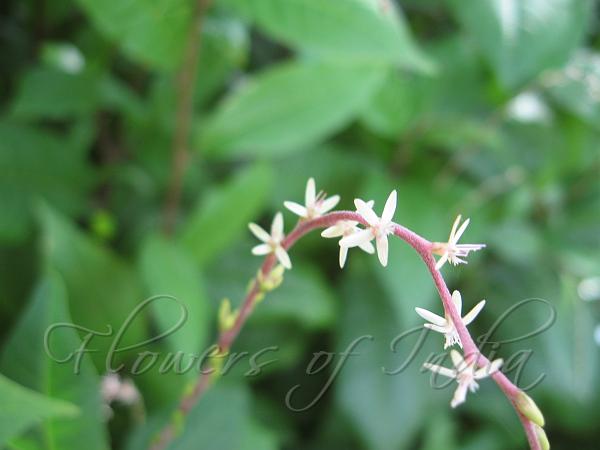|
| Guinea Henweed |
|

|

| File size | 397104 |
| Original date | 8/16/08 3:48 PM |
| Resolution | 1600 x 1200 |
| Flash | Flash did not fire, auto, red-eye reduction |
| Focal length | 5.8mm |
| Exposure time | 1/60s |
| Aperture | 2.6 |
| Focus Distance | |
| Metering Mode | Multi-segment |
| Camera make | Canon |
| Camera model | Canon PowerShot A530 |
| Sensor type | OneChipColorArea |
|
|
|
|
Photo: |
Botanical name: Petiveria alliacea Family: Phytolaccaceae (Pokeweed family)
Synonyms: Mapa graveolens, Petiveria corrientina, Petiveria foetida, Petiveria graveolens
Synonyms: Mapa graveolens, Petiveria corrientina, Petiveria foetida, Petiveria graveolens
Guinea Henweed is a deeply rooted herbacious perennial shrub native to
tropical areas of Africa, South and Central America and the Caribbean. It
has now naturalized in India. It grows up to 1 m tall, and has velvety to
smooth stems. The roots and leaves have a strong, garlic-like odour which
taints the milk and meat of animals that graze on it. It produces dark
green leathery leaves that lie close to the ground and tall spikes lined
with small white flowers that sway above the leaves. Leaves are
elliptic to oblong or obovate, to 20 × 7 cm, with 0.4-2 cm long stalks.
Base is acute to wedge-shaped, tip is narrow or acute to obtuse or
rounded. Flowers are regularly spaced, with white or greenish to pinkish,
linear-lanceshaped to linear-oblong sepals, about 3.5-6 mm long.
Medicinal uses: Guinea Henweed has been widely used to treat an
astounding range of medical conditions both in humans and in animals
including: venereal diseases, an antiseptic, arthritis, pain, cancer, womb
inflammation, diuretic, decoagulant, cold, snake bite, flu, cods,
hysteria, paralysis, fever, rabies, to treat arrow poison in Brazil and as
a bat and insect repellent.
Guinea Henweed has been widely used to treat an
astounding range of medical conditions both in humans and in animals
including: venereal diseases, an antiseptic, arthritis, pain, cancer, womb
inflammation, diuretic, decoagulant, cold, snake bite, flu, cods,
hysteria, paralysis, fever, rabies, to treat arrow poison in Brazil and as
a bat and insect repellent.
Medicinal uses:
 Guinea Henweed has been widely used to treat an
astounding range of medical conditions both in humans and in animals
including: venereal diseases, an antiseptic, arthritis, pain, cancer, womb
inflammation, diuretic, decoagulant, cold, snake bite, flu, cods,
hysteria, paralysis, fever, rabies, to treat arrow poison in Brazil and as
a bat and insect repellent.
Guinea Henweed has been widely used to treat an
astounding range of medical conditions both in humans and in animals
including: venereal diseases, an antiseptic, arthritis, pain, cancer, womb
inflammation, diuretic, decoagulant, cold, snake bite, flu, cods,
hysteria, paralysis, fever, rabies, to treat arrow poison in Brazil and as
a bat and insect repellent. | Identification credit: Shanker Rao | Photographed in Bangalore. |
• Is this flower misidentified? If yes,